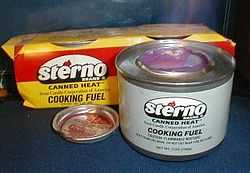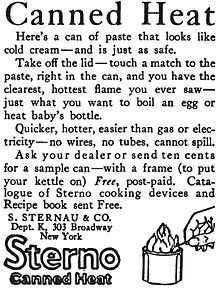Sterno

Sterno ("Canned Heat") is a fuel made from denatured and jellied alcohol. It is designed to be burned directly from its can. Its primary uses are in the food service industry for buffet heating and in the home for fondue and as a chafing fuel for heating chafing dishes. Other uses are for camp stoves and as an emergency heat source. It is also a popular fuel for use with toy and model steam and other external combustion engines.
History

The Sterno brand and trademark is owned by the Sterno Group LLC, which is a subsidiary of Candle Lamp Company LLC as of October 2012.[1] The name comes from that of the original manufacturer: S. Sternau & Co. of Brooklyn, New York, a maker of chafing-dishes, coffee percolators and other similar appliances since 1893. It had previously applied the name to its "Sterno-Inferno" alcohol burner. In 1918, it promoted its Sterno Stove as being a perfect gift for a soldier going overseas.[citation needed] In his book "with the Old Breed" E.B.Sledge describes its use on the battlefields of the Pacific Theatre in 1944,45.
Invented around 1900, Sterno is made from ethanol, methanol, water and an amphoteric oxide gelling agent, plus a dye that gives it a characteristic pink color. Designed to be odorless, a 7 oz (198 g) can will burn for up to two hours. The methanol is added to denature the product, which essentially is intended to make it too toxic for consumption.
In 2007, two NASCAR crew chiefs were fined $100,000 for lining their fuel tanks and intake valves with Sterno. When the highly regulated NASCAR fuel was added, the Sterno would liquify, giving the car an added octane boost.[2]
As a drink
There are many instances of people drinking Sterno to become intoxicated. Bluesman Tommy Johnson alludes to the practice in his song Canned Heat Blues recorded in 1928.[3]
The practice is said to have become popular during the Great Depression in hobo camps, or "jungles", when the Sterno would be squeezed through cheesecloth or a sock and the resulting liquid mixed with fruit juice to make "Jungle Juice" or "Squeeze".[4]
The 1956 American documentary On the Bowery includes footage of three homeless men straining Sterno cooking fuel to make "squeeze" and then drinking the alcohol.[5]
In an article for the Journal of the American Medical Association in 1961, Capt. James H. Shinaberger, MC writes about a study of three people who had suffered methanol poisoning as a result of drinking Sterno. One of the patients, "had been drinking Sterno for about a week and had been in the city prison for 48 hours when severe abdominal pain and vomiting occurred".[6]
In December 1963, a rash of 31 deaths in Philadelphia's homeless population were traced to a local store that knowingly sold Sterno to people for them to consume and get drunk.[7]
In Michael Crichton's 1969 novel "The Andromeda Strain" and the 1971 movie based on it, one of the survivors of the deadly extraterrestrial virus is an old man who utilizes "Squeeze" along with aspirin to alleviate the pain caused by a bleeding ulcer diagnosed two years prior to the "Piedmont Incident". Constant consumption of Sterno has altered his blood pH, making him at least temporarily immune to the disease.
See also
References
- ↑ insideview.com. The Sterno Group LLC retrieved 2012 Nov 27
- ↑ Coble, Don (February 12, 2007). "Waltrip could face a Sterno penalty". The Florida Times-Union. "[...] inspectors found a gel-like coating inside the manifold. Several engine builders from other teams said the substance appeared to be Sterno, a bluish gel that could provide a hotter, cleaner burn inside the engine to create more horsepower."
- ↑ National Park Service, Trail of the Hellhound: Tommy Johnson Accessed on 10/09/11
- ↑ "Police Start Drive on Drinkers of Canned Heat", The Sarasota Journal, January 5, 1962.
- ↑ "On The Bowery" Turner Classic Movies
- ↑ Shinaberger, J. H. (1961). "Treatment of Methanol Poisoning by Extracorporeal Dialysis". Archives of Internal Medicine 108 (6): 937–939. doi:10.1001/archinte.1961.03620120121016.
- ↑ "Commonwealth of Pennsylvania v. Max Feinberg (1969) 433 Pa. 558, 253 A.2d 636".